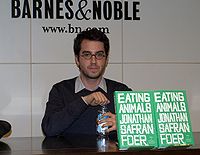Eating Animals

Jonathan Safran Foer at Barnes & Noble Union Square to discuss his book Eating Animals
|
|
| Author | Jonathan Safran Foer |
|---|---|
| Country | United States |
| Language | English |
| Genre | Non-Fiction |
| Publisher | Little, Brown and Company |
|
Publication date
|
2009 |
| Pages | 352 pages (hardcover) |
| ISBN | |
| LC Class | TX392 .F58 2009 |
Eating Animals is the third book by the American novelist Jonathan Safran Foer, published in 2009. It was written in close collaboration with Farm Forward, a 501(c)(3) nonprofit organization that implements innovative strategies to promote conscientious food choices, reduce farmed animal suffering, and advance sustainable agriculture. A New York Times best-seller,Eating Animals provides a dense discussion of what it means to eat animals in an industrialized world.
Foer presents the book as a way for him to decide whether or not his newborn child should eat meat. Foer’s son is representative of the generations that are entering a world of industrialized farming, in which the decision to eat meat has many more implications than taste. More often than not, putting meat on our plates comes with immense ramifications not only for the animals involved, but also for the environment, and ourselves; the animals suffer, the environment is damaged, and our health is put into question. Essentially, Foer concludes that the detriments of factory farms outweigh the benefits of taste, which is why he chooses to raise his son a vegetarian.
Throughout the book, Foer places significant emphasis on the stories that come with food. To strengthen the emphasis, both the first and the last chapters of the book are entitled “storytelling.” In the book, Foer states that “stories about food are stories about us―our history and our values,” and establishes storytelling as the overriding theme of the whole book. For Foer, storytelling is a way of recognizing and dealing with the complexity of the subject that is eating animals, and how it is connected to identity. The stories in our plates are the stories about our relationship with the world as represented by the people we eat with, the process by which our food reaches the table, what kinds of food find their ways to our table, etc. According to Foer, the way humans cope with and understand complex phenomena is by turning their occurrences into stories about what they mean. In this sense, the suggested profundity within the phenomenon of meat eating gives Foer’s concept of storytelling a religious undertone.
As the title suggests, the particular phenomenon Foer focuses on is the consumption of meat. He discusses what eating meat has meant in the past, and what it means today. In doing so, he does not, as one might expect, make the claim that eating meat is intrinsically bad. Rather, he claims that eating meat is circumstantially bad; for example, it is bad when it entails the suffering of animals, environmental destruction, and/or a risk for human health. Today, according to the book and a number of its cited sources, eating meat overwhelmingly entails these problems, while in the past, it has not. The conclusion Foer reaches is that eating animals that come from industrial methods―such as factory farming, industrial fishing, and the like―is bad.
...
Wikipedia
